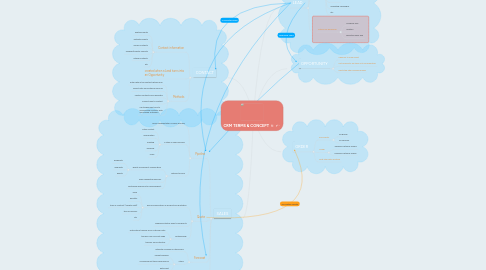
1. CONTACT
1.1. Contact information
1.1.1. existing clients
1.1.2. potential clients
1.1.3. vendor contacts
1.1.4. supplier/investor conacts
1.1.5. retailer contacts
1.1.6. etc
1.2. created when a Lead turns into an Opportunity
1.3. Methods
1.3.1. enter data in the contact details form
1.3.2. import data from external sources
1.3.3. capture contacts from websites
1.3.4. convert lead to contact
1.3.5. use technology tools to synchronize contacts with specialized softwares
2. SALES
2.1. Pipeline
2.1.1. visual representation of sales process
2.1.2. 5 steps in sales process
2.1.2.1. initial contact
2.1.2.2. qualification
2.1.2.3. meeting
2.1.2.4. proposal
2.1.2.5. close
2.1.3. Method to build
2.1.3.1. quality of prospect classification
2.1.3.1.1. prequality
2.1.3.1.2. disquality
2.1.3.1.3. quality
2.1.3.2. make requesting referrals
2.1.3.3. customize approach to each prospect
2.2. Quote
2.2.1. Record information of products for quotation
2.2.1.1. price
2.2.1.2. quantity
2.2.1.3. time of contract ( validity date)
2.2.1.4. time of delivery
2.2.1.5. etc
2.2.2. prepare potential sales to prospects
2.2.3. Methodology
2.2.3.1. automaticly transfer from customer data
2.2.3.2. transfer from account page
2.2.3.3. transfer from Potential
2.3. Forecast
2.3.1. estimate company's future sales
2.3.2. Steps
2.3.2.1. market research
2.3.2.2. comparing last term performance
2.3.2.3. data audit
2.4. Activity
2.4.1. tactics salespersons use to achieve their goals and objectives
2.4.2. steps
2.4.2.1. activity identification
2.4.2.2. activity reporting
2.4.2.3. activity reviewing
2.4.2.4. action plan
3. LEAD
3.1. Potential customer (contact/account)
3.2. Sources
3.2.1. conference
3.2.2. trade show
3.2.3. advertisement
3.2.4. phone books
3.2.5. webpages
3.2.6. marketing campaigns
3.2.7. etc
3.3. Criteria for qualifying
3.3.1. company size
3.3.2. location
3.3.3. expected sales size
4. ORDER
4.1. Documents
4.1.1. for goods
4.1.2. for services
4.2. Usage
4.2.1. Tracking customer orders
4.2.2. Fulfilling customer orders

